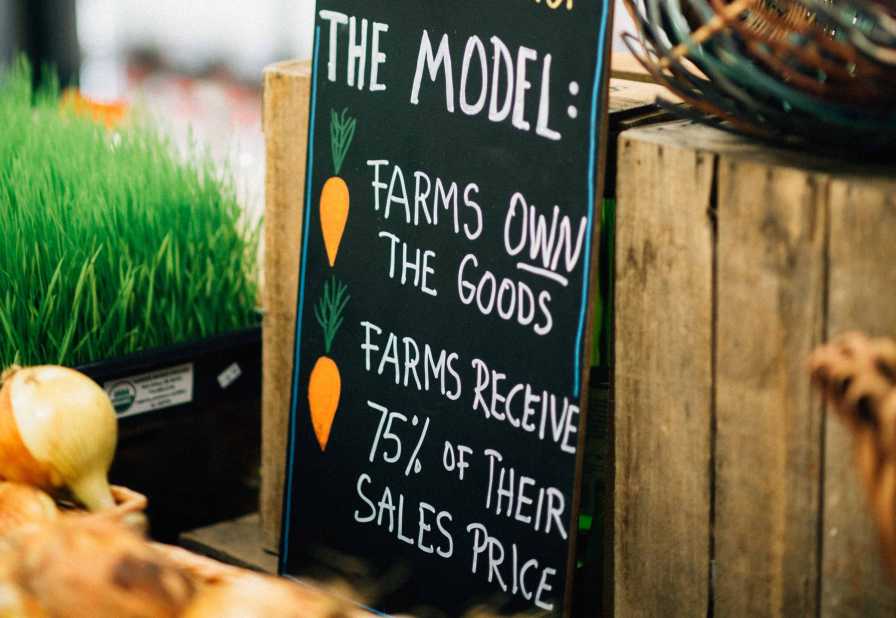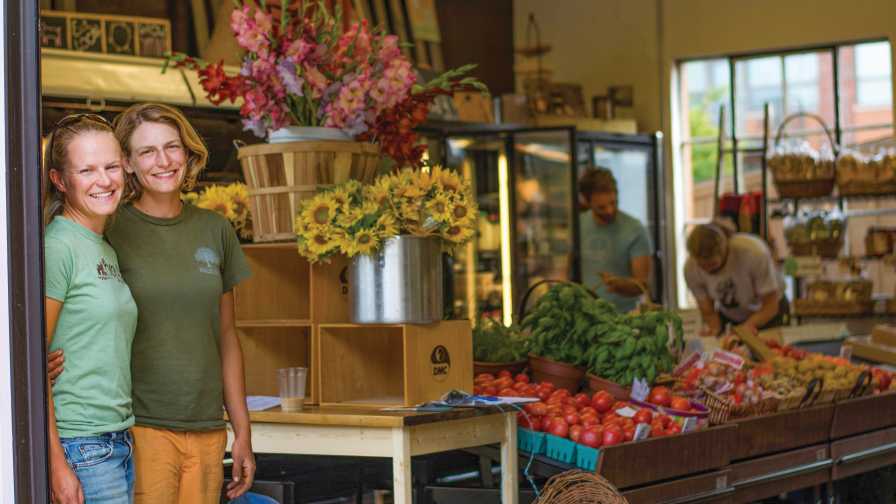How to Get a Bigger Cut of Your Farm Crop’s Retail Price

The Argus Farm Stop retail model is simple if you look at it.
Photo courtesy of Brinkerhoff Photography
You might be experiencing a situation similar to our own — and many other areas in the U.S. More than 90% of farms have disappeared from our county here in Michigan since 1950 (2012 Census of Agriculture). The average age of farmers is 58 — and more than 10 million acres of farmland are expected to leave farming in the next five years.
Under our current food system, farmers receive only 15 cents of the retail sales dollar — 85 cents go to distributors, shippers, and retailers. At that pricing level, it is almost impossible for small to medium farms to compete.
There has to be a better way!
We work with Michigan farmers on an emerging retail model that ensures producers receive most of the retail price for their crops and livestock. It’s such a popular model that groups from across the country have visited us for a three-day internship to learn how to create their own farmer-friendly model.
We think you and your peers could create a store like ours. It’s time growers gained some power of their income.
What Is the Farm Stop Model?
Argus Farm Stop takes an everyday farmers market (where the farms own and price their products) and offers shoppers the convenience of a grocery store.
The farm stop model is like a grocery store in that it has high-quality refrigeration and one main checkout area. Financially, however, it’s closer to a farmers market, with growers owning the produce and getting 75% of retail sales (five times the national average!).
As you can imagine, it’s not a highly profitable business model. For that reason, we have an L3C license, which designates Argus as a socially beneficial, low-profit business. If you choose to start a farm stop of your own, you’re doing it to benefit your fellow local producers.
In order for the model to work financially, we have a really nice coffee/espresso operation (more on that later).
Farms drop off products in ready-to-sell condition, and Argus stocks, replenishes, and educates customers about each farm’s products and growing practices. Farmers have more time to farm, and customers can shop any day in a way that maximally supports farms.
We allow deliveries any time during the week, and farmers can meet customers at the store (which they love). Argus has high-quality refrigeration and displays that give our local farm products the pedestals they deserve. We carry exclusively local products ranging from fresh produce (refrigerated and non-refrigerated), dairy, prepared foods, meats, and grocery items.
It’s a model that appeals strongly to customers and producers. Here are five tips to help make this work:
1. Select Farms and Producers
We try to have three to four alternative producers for any given product. This gives customers the choice between different growing practices (e.g., certified organic, organic practices, etc.) and different product types.
It is a continual curation of product mix. We have had very little turnover for five years and currently have a waiting list in most product categories. Our farms have continuously improved and are growing deeper into the shoulder seasons, so our market looks great year-round.
2. Store Location and Size Tips
Finding just the right location can be tricky. To attract customers, you want to be in a retail-friendly area — urban or suburban — and in a fairly good-size community.
We renovated an abandoned, former gas station next to our downtown in 2014. It’s in a vibrant, old west side neighborhood. It’s on the small side at 1,300-square-feet, but it serves our needs and has storage areas in the rear and a front parking area.
That said, in 2016 we added a greenhouse for additional seating. These kinds of old service stations are in almost every town and make great locations for a farm stop.
3. Coffee Is Important!
When we ran the financials for a store that would pay out 75% to 80% to farms, we quickly realized we needed high-margin sales that could help pay the rent and staff wages. Given the store’s small size, it would be difficult to reach the volume of sales we’d need. So we built a café.
The café contributes about one third of the sales, but around half of the margin. It’s key to making our farm stop work.
And it does a lot more for our model than boost us financially. Perhaps the larger benefit lies in how coffee and tea builds community. All of the farms and producers selling through the store get free coffee at Argus when they deliver product. This gives them a brief respite during the day to chat with customers before heading on with the rest of their day. The customers love getting to know those who feed their families.
We have become a reliable destination for a great cup of coffee, which directly helps pay for the local food mission.
4. Store Layout Considerations
The store layout includes high-quality refrigeration designed to give local produce, dairy, and meats the effective displays they deserve. We purchased most of these used and had new compressors installed.
Size can have an impact on how customers perceive your success. Since we are locally sourced, with a natural limit on suppliers, we realized that our store could potentially look picked over when inventory is low. We decided to have a slightly smaller store so that displays remain abundant and energy stays high.
And it’s worked. We are able to keep it looking full and vibrant year round. That became especially important when farms realized we could sell their winter produce and they started growing much more.
We value encouraging a sense of community. So we devote space for customers to sit and visit. That includes larger communal tables and making the seating face in toward the center of the store, rather than looking out the windows. It is terrific to see a farmer stopping for a break and sitting next to a family from the local neighborhood.
5. Staffing Suggestions
When it comes to retail, passion and personality matter more than skills. You can always train skill levels.
We have built an amazing staff of talented folks who are passionate about local food. Our Store and Operations Manager Laura Barch came to us with experience from running a local café.
We have also promoted internally to fill out an impressive team that continually amazes us with their abilities and desire to have an impact on the local food economy.
Between both stores, we now have more 45 staff members. We have used the ZingTrain model of customer service (offered by the renowned Zingerman’s) and woven this completely into our culture.

Sisters Amanda Sweetman (left) and Jill Lada (right) supplied Argus Farm Stop during its opening months. Today, Sweetman is the Regional Director of Farming and Healthy Lifestyles for Trinity Health in Michigan, and Lada is an owner of Green Things Farm Collective, which still sells produce at the store.
Photo courtesy of Brinkerhoff Photography
How Has It Worked Out?
Argus has turbocharged our local food economy. We started with 30 farms/producers in 2014 and have grown to more than 200 in 2019. Since we opened, we paid more than $6 million to farms, with the top 20 farms selling more than $44,000 each in 2018.
We’ve made many operational improvements and opened a second location. Our second location is bustling and the neighborhood has embraced us. We’re happy to report that our 2019 sales were $2.6 million.
With a convenient indoor location, local food sales continue strongly through the winter, with about 35% of annual sales occurring between January and May.
We also see great season extension in the products being sold through the store. We also accept EBT (Electronic Benefits Transfer) and Double Up Food Bucks programs to improve food access in our area.










